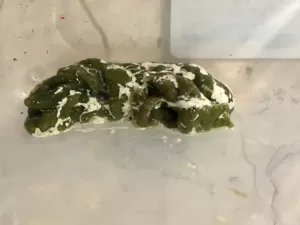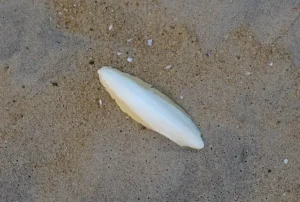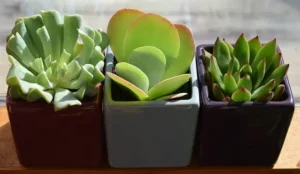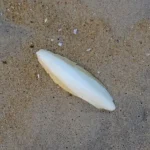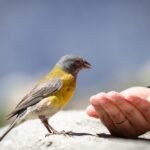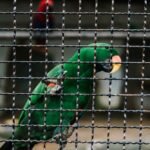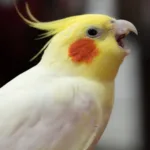Checking on your parrot’s droppings regularly can be a good way to stay informed on your parrot’s health especially because they have the instinct to hide their illnesses.
However, new owners can often get confused while trying to understand the different aspects of parrot poop all at the same time.
So to help you learn about your parrot dropping in a clear and easy way, I am going to walk you through parrot poop in the following order – the color, consistency, contents, frequency, and finally odor. But first, you should know what healthy parrot poop looks like.
Quick Navigation
What Does Healthy Parrot Poop Look Like?
A healthy parrot poop typically has a toothpaste-like texture, olive green feces, white urates, and clear urine.
If you’re not familiar with the composition of parrot poop, you may find that description hard to follow. In order to identify what normal poop looks like, you need to know about the components of parrot poop.
The Three Components Of Parrot Poop
Birds do not have separate openings for urine and feces. As such, they expel their waste products from a single opening called the cloaca. Their dropping consists of three main parts:
- Feces (solid waste): The feces are the actual waste products. They take a tube-like form and a soft texture.
- Urates (semi-solid waste): Urates are the white and creamy part that surround the feces. They consist of uric acid and other substances filtered out by the kidneys.
- Urine (liquid waste): The urine surrounds the urates and is typically a clear liquid.

Parrot Poop Color Meanings
The color of parrot droppings can be influenced by a number of things, including their diet. A healthy diet usually consists of high-quality pellets, fruits, and vegetables. But sometimes they may eat more colorful fruits which could affect the color of their droppings.
Light Green
Olive green poop or slight variations of that color are generally considered normal in parrots. It is a normal color in parrots eating seeds or even a mixed diet.
However, if your parrot’s droppings are a distinct pea green or lime green color, it can be an indication of liver disease. Along with the feces, you may also notice the color change in the urates.
Yellow
If your parrot’s droppings as well as the urates are yellow and also appear to be dry and crumbly, it may suggest the following conditions:
- Liver disease.
- Chlamydophila psittaci bacteria.
- Anorexia (Not eating).
- Dehydration.
Red
Most people get worried when they see red-colored poop and think that it is blood. But it is not always code red, so don’t be alarmed. The red color in parrot’s droppings can be a result of eating red-colored food.
If your parrot has recently eaten something like strawberries, beets, red bell peppers, raspberries, or any other red food item, it can make the droppings appear red in color.
If the color in your parrot’s poop is because of consuming red food, the red tint will usually fade out after a few droppings. However, in case the color doesn’t disappear, you need to closely examine the droppings for any signs of blood.
Blood In Parrot Poop
Blood in parrot poop is typically an indication of bleeding in the lower rectum or gastrointestinal tract. It is different from melena, which refers to the presence of digested blood in the feces. It occurs when there is bleeding in the upper gastrointestinal tract.
If your parrot is pooping blood, it can typically be examined in two ways:
- Streaks of blood in the stool
- Drops of blood around the stool
Any signs of blood in your parrot’s droppings is an emergency situation and it is essential to visit an avian veterinarian. They will be better able to determine the cause of the bleeding and provide appropriate treatment.
Possible reasons for blood in parrot poop:
- Rectal injuries
- Ulcers in cloaca
- Egg binding
- Bowel obstruction
- Heavy metal toxicosis
- GI infections
Purple
If you notice that your bird’s poop is purple or blueish in color, it could again just be because of a colorful diet. Food can influence the color of droppings to a great degree and it is generally not concerning when it happens.
It’s okay for the poop to have some temporary color changes during the day based on what the bird eats. These are some of the foods that could make your parrot’s poop appear purple or blue:
- Blackberries
- Grapes
- Purple cauliflower
- Blueberries
- Currants
Black
Black and tarry poop is characteristic of melena in parrots. It is indicative of internal bleeding in the upper gastrointestinal tract. The blood becomes dark and tar-like because it is digested as it passes through the GI tract.
It must be noted that melena can be a symptom of serious underlying medical problems and must be diagnosed by an avian vet. Some possible causes of melena include:
- Foreign bodies in the GI tract
- Cancer
- Bacterial infections
- Ulcers in the stomach
Brown
Red or dark brown poop could be a sign of internal bleeding. A reddish brown color is often suggestive of heavy metal poisoning. The stool may also have a tarry consistency because of the digested blood.
White
White droppings with a chalky appearance and more water content may indicate problems with the digestive organs. It can be due to larger-sized urates and smaller feces in the droppings, which is unusual and must be checked out.
Consistency Of Parrot Poop
The consistency of parrot droppings also varies based on the diet. Ideally, the parrot poop should have a paste-like consistency. It should not be too dry or have too much water content.
Why Is My Parrot Poop Watery?
With urates and feces, parrots also expel a clear liquid. So some amount of water is normal in your bird’s droppings. However, if you find that there is excess urine present in the droppings, it could be attributed to a few different causes.
- Water-rich foods in the diet
- Polyuria
- Electrolyte imbalance
- Polydipsia
- Diabetes mellitus
It could sometimes occur when parrots have too many water-rich foods in their diet. These include foods like watermelon, grapes, oranges, cucumber, etc. This is generally nothing to worry about and resolves itself when the bird returns to its normal diet.
However, there can be other reasons that you need to take into consideration. Many parrot owners mistake watery poop for diarrhea. However, excess urine is actually the result of polyuria.
Polyuria refers to increased urine production, leading to liquid waste in the droppings. Polyuria can be caused by factors such as kidney disease and other underlying diseases.
Parrots usually don’t consume much water in a day but in case you notice that your parrot is drinking a lot of water, that is, frequently visiting its water bowl and being thirsty all the time, it could have polydipsia. It could be another reason why your parrot has more urine content in its droppings.
Why Is My Parrot’s Poop Loose?
Loose or wet droppings are typically a sign of diarrhea in parrots. A diarrheic poop will have unformed feces and may get mixed with the urates and urine. It may be hard to distinguish between the different components of parrot poop because it is mixed all together.
Why Is My Parrot’s Poop Dry?
If your parrot’s poop is dry it means that your parrot is dehydrated or not drinking enough water.
It can also be due to kidney problems.
Why Is My Parrot’s Poop Chalky?
Urates are typically white and chalky. This is normal and often doesn’t indicate any problem. But if there are more urates in the droppings, it indicates that the kidneys are not functioning properly.
Contents In Parrot Poop
Ideally, you should not find any substance in your parrot’s poop other than the feces and urates. But if you can spot any unusual substances in your parrot’s droppings with your naked eye, it could suggest digestive issues with the bird.
Bubbles In Droppings
According to The Avian Welfare Coalition, bubbles or air pockets in a parrot’s poop is a sign of infections or GI problems. These may be caused by the presence of gas in the stomach, which is not normal for parrots.
Occasionally, you may see small bubbles in your parrot’s droppings as they squirt it all out. However, if these bubbles continue to form on the droppings for more than a day, you should see an avian vet.
Undigested Food In Droppings
Droppings that appear bulky or carry undigested seeds are indicative of pancreatic disease. A parrot pooping out whole seeds could suggest a problem with the gizzard or a disease called proventricular dilatation. This a very serious disease and a proper diagnosis with an avian vet is warranted.
Worms And Parasites In Poop
In most cases, intestinal parasites are not visible to the naked eye. These parasites, such as ringworms or protozoa are microscopic organisms. Therefore, they are hard to detect without proper diagnosis.
In the odd case where you are able to clearly see these worms in the droppings and your parrot’s vent area, it means the infestation has advanced to a serious stage. It happens when the issue has been unaddressed for a long time. It is an alarming sign that you need to take your parrot to the vet immediately.
Here are some signs of worm infestation in parrots:
- Weight loss.
- Loss of appetite
- Weakness.
- Diarrhea.
- Droppings stuck near the vent.
Frequency Of Parrot Poop
The size and frequency of your parrot’s droppings will vary depending on the species. But generally speaking, most parrots poop anywhere from 30-50 times a day or every 15-30 minutes.
Why Is My Parrot Pooping So Much?
Parrot’s normally poop quite often but if you notice an increase in the frequency of droppings, it can be due to digestive issues such as diarrhea, or diabetes mellitus.
In a different scenario where the volume of poop seems to have increased and you notice much larger yet less frequent droppings, it could be because your parrot is about to lay eggs.
During the nesting season, parrots poop much less frequently but in more quantity at one time because they only have one exit.
Why Is My Parrot Pooping Less?
Infrequent or fewer droppings can also be a cause for concern. When a parrot is not pooping as often, it could be due to the following reasons:
- Not eating enough.
- Constipated.
- Obstruction in the vent.
Why Is My Parrot Not Pooping?
If your parrot is constipated or the number of dropping per day has decreased abruptly, it could potentially have the following causes:
- Changes in diet
- Dehydration
- Egg-binding
- Internal blockage
Odor
A healthy parrot poop does not have an odor. Because parrots poop so often, the feces do not stay in their stomach for long, hence the droppings have no odor. However, the first poop of the day might smell a bit because the parrot has been holding it all night.
Why Does My Parrot’s Poop Smell Bad?
Smelly poop can be indicative of infections and diseases. There can be a myriad of causes attributed to foul-smelling droppings so it is important to get it examined by a vet.
Abnormalities In Urates And Urine In Droppings
The urate should always be white in color with a creamy texture while the urine in the dropping should be clear. Any deviation from this indicates abnormalities in the poop.
No Urates In Bird Poop
The absence of urates in the droppings suggests problems with the kidney because the urates are produced by the kidneys. Both urates and urine are filtered waste material that comes from the kidney, so the absence of either one of them is indicative of renal disease.
Parrot Urine Cloudy
Urine surrounds the urates which border the feces. Each of the three components does not mix with one another which leads to clear urine. But when the parrot is diarrheic, the feces are not well formed and may blend with the liquid urine giving it a cloudy appearance.
Yellow Bird Urine
One common reason for yellow-colored urine is dehydration. The urine may sometimes also appear to be discolored or different from its normal clear appearance. You should address this issue by checking on your parrot’s hydration levels.
Look for these signs of dehydration:
- Sunken Eyes
- Dry Mouth
- Reduced Elasticity Of The Skin
- Panting
- Changes In Poop Consistency
- Lethargy
However, another reason why the urine may turn yellow could be the presence of carotenoids in their diet. It may happen due to the presence of certain B vitamins and natural pigments present in some food, such as fruits or vegetables.
Some bird foods also contain food dyes, which can give a yellow color to the urine. If you have recently changed your parrot’s diet, you can switch it back and see if the urine color changes to normal.
